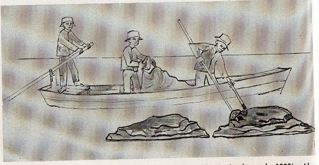Image: “Chinese fishermen gathering abalones off California in the early 1800s. Abalones were knocked off rocks by a wedge on the end of a pole and drawn up with a gaff. This method is still used in parts of Asia. Brush drawning by R.B. Lucas, 1961.” From: By Keith W. Cox, California Dept. of Fish & Game, 1962.
“Not until the Chinese arrived in the early 1850s were California’s abalones gathered by other than Indians. Brought to this country as cheap labor to help build railroads and to work mines, the Chinese were quick to associate local abalones with those of their native land where they were important food items. It is these people to whom the credit must be given for originating our abalone fishery. In their own country, Chinese peasants were forbidden by law to gather abalones (Albrecht, 1917); in this country no such regulations existed. There was soon a thriving industry and by 1879 California commerical landings of abalone meat and shell were over 4.1 million pounds per year. Green and black abalones were the predominant species in these early years.
“These early abalone fishermen worked the intertidal area from skiffs. According to Keep (1890), they would row among the rocks at low tide searching the cracks between exposed boulders and examing the submerged rocks. Using a long pole with a wedge on one end, they would knock an abalone off a rock and then draw itup with a boat hook.
“Although these methods were primitive, they seem to have quite effective. These fishermen who were concerned only with numbers soon stripped the shores and seriously depleted the abalone stocks. When this happened, the fishery, which had been centered at San Diego, was extended into Baja California and abalone camps were also established on San Clemente, Santa Catalina and several other Channel Islands.
“In 1880, the Mexican government became so concerned at the efficiency of the Chinese operations in Baja California they set a license fee of $60 per boat and established a consulate at San Diego to keep records on the fishermen. The California coastal counties also became alarmed at the rate these mollusks were being taken and in 1900 ordinances were passed making it unlawful to fish for abalones excep tin deeper water.
“Since the Chinese were not divers, having done their harvesting in the intertidal zone and from skiffs, these ordinances effectively eliminated them from the fishery. Their place was then taken by Japanese “sake barrel” divers (Albrecht, 1917), who worked the offshore waters that could not be reached by the Chinese pole fishermen. The name for this type of diving was derived from the barrels, originally containing the Japanese sake or rice wine, shipped to this country from the Orient. The divers used them as floats to rest on between dives. This float method is still used in parts of Japan and the Orient by the shellfish and seaweed divers.”
More to come

